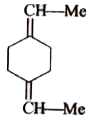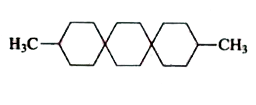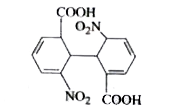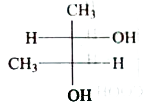Which of the following compounds are optically inactive but exhibit geometrical isomerism?




The correct Answer is:B, C, D
To determine which compounds are optically inactive but exhibit geometrical isomerism, we can follow these steps:
Step 1: Identify Optical Inactivity
Optical inactivity in a compound typically occurs when there is a plane of symmetry or a center of symmetry. This means that if you were to divide the molecule in half, both halves would be mirror images of each other.
- First Compound: Check for a plane of symmetry. If it has one, it is optically inactive.
- Second Compound: Again, check for a plane of symmetry. If it has one, it is optically inactive.
- Third Compound: Check for a plane of symmetry. If it has one, it is optically inactive.
- Fourth Compound: Check for symmetry. If it lacks any plane of symmetry, it is optically active.
Step 2: Determine Geometrical Isomerism
Geometrical isomerism occurs when there are restricted rotations around a bond (such as a double bond or a ring structure) and two different groups attached to the carbon atoms involved in the bond.
- First Compound: Analyze the structure. If it has restricted rotation and two different groups, it exhibits geometrical isomerism.
- Second Compound: Check for restricted rotation and different groups. If it meets the criteria, it exhibits geometrical isomerism.
- Third Compound: If it is already in a cis or trans configuration, it exhibits geometrical isomerism.
- Fourth Compound: If it has identical groups on one side, it does not exhibit geometrical isomerism.
Conclusion
After analyzing the compounds:
- Compounds 1, 2, and 3 are optically inactive (due to the presence of a plane of symmetry) and exhibit geometrical isomerism.
- Compound 4 is optically active and does not exhibit geometrical isomerism.
Thus, the answer to the question is Compounds 1, 2, and 3.
---
Optical inactivity in a compound typically occurs when there is a plane of symmetry or a center of symmetry. This means that if you were to divide the molecule in half, both halves would be mirror images of each other.
- Second Compound: Again, check for a plane of symmetry. If it has one, it is optically inactive.
- Third Compound: Check for a plane of symmetry. If it has one, it is optically inactive.
- Fourth Compound: Check for symmetry. If it lacks any plane of symmetry, it is optically active.
Geometrical isomerism occurs when there are restricted rotations around a bond (such as a double bond or a ring structure) and two different groups attached to the carbon atoms involved in the bond.
- Second Compound: Check for restricted rotation and different groups. If it meets the criteria, it exhibits geometrical isomerism.
- Third Compound: If it is already in a cis or trans configuration, it exhibits geometrical isomerism.
- Fourth Compound: If it has identical groups on one side, it does not exhibit geometrical isomerism.
After analyzing the compounds:
- Compounds 1, 2, and 3 are optically inactive (due to the presence of a plane of symmetry) and exhibit geometrical isomerism.
- Compound 4 is optically active and does not exhibit geometrical isomerism.
Similar Questions
Knowledge Check
- Question 1 - Select One
Which of the following compounds is optically inactive?
A B
B C
C D
D
- Question 2 - Select One
Which of the following compound is optically inactive ?
ACH3⋅CHOH⋅CH2⋅CH3BH2C=CH⋅CH2⋅CH=CH2C D
D
- Question 3 - Select One or More
Which of the following compgunds would be optically inactive?
AH2=CH2B CH3C−CH=C=CH−CH3D
CH3C−CH=C=CH−CH3D
Which of the following compound is achiral ( optically inactive )?
View SolutionWhich of the following amino acid is optically inactive?
View SolutionWhich of the following is an optically inactive compound?
View SolutionWhich of the following compound show optical isomerism?
View SolutionWhich of the following types of compounds is unable to exhibit geometrical isomerism ?
View Solution


